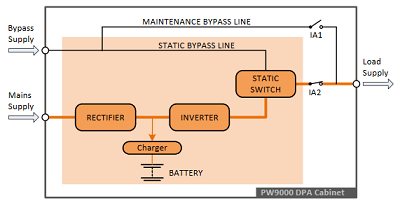While UPS power supplies have been an integral part of data centre operations for many years, expectations of their performance have increased steadily – and current trends in data centre design are set to increase this pressure further.
As customers expect on-demand access to services in a 24/7-transaction environment, businesses are looking for UPS power systems, which counter the falling tolerance of data loss due to power interruptions. High uninterruptible power supply availability, therefore, becomes essential, yet it must be achieved with high electrical efficiency, as a number of factors will potentially affect the UK’s energy capacity, whilst driving prices up.
In this article, Alan Luscombe, director at KOHLER Uninterruptible Power Ltd., a KOHLER company, discusses the latest in modular UPS topology and shows how data centre managers can use it to achieve the power availability and efficiency vital to today’s business climate.
If you’re responsible for data centre operations or other IT installations of any significance, the drive to secure the maximum possible availability from your UPS power systems will no doubt have intensified steadily over recent years. Organisations increasingly conduct their transactions online, while their customers rely on real-time responses on demand, 24/7.
In this environment, being forced offline through a data centre system failure could have severe commercial and reputational consequences, yet this can happen if the susceptible electronic equipment is exposed to even the briefest of power failures or disturbances. So a UPS power system’s highest priority is to secure near-perfect power availability for itself, the power infrastructure and its supported load.
But it’s not the only priority. Although no one knows exactly what will happen to energy prices, they are high, with many factors liable to drive them higher in the future. According to a Telegraph report, figures from the National Grid at the beginning of the year suggested that there would not be enough power plants operating in the UK to keep the lights on for most of December, January and February. The supply gap emerged because a series of old, polluting power stations have been shut down, with insufficient new plants being built to replace them. This is the first time since the published data system began in 2001 that a shortfall rather than a surplus of spare UK power plants has been forecast.
National Grid can and will solve these problems by bringing in backup plants and by buying in more power from the Continent, but these measures are likely to push prices up. Other factors could also increase demand: we could, for example, have a cold winter, compared with the average conditions assumed in the forecast. The forecasts also assume a UK wind generation of over 3 GW, while wind farms produce almost nothing on a still day. Therefore, levels of wind power cannot be assumed as available when needed.
All of this means that facility managers are seeking UPS power systems that offer the most efficient possible operation along with the highest availability that can be practically achieved. Fortunately, evolution in uninterruptible power supply technology, particularly modular UPS solutions, enables implementations that can satisfy both these objectives.
Modular UPS systems
The most important step in this evolution has been the transition to transformerless technology. This above all has made modular UPS topology possible, simply due to the substantial reductions in size and weight achieved, not only by eliminating the transformer itself but also by removing the need for the 12-pulse rectifier previously required to improve input THDi performance. These reductions allow the implementation of complete UPS power systems as transportable rack-mounting modules rather than monolithic floor-standing UPS installations.
Accordingly, modern modular UPS systems comprise a number of modules mounted into a 19” racking unit. With a single module typically offering 100 kW capacity, large-scale UPS installations for major data centres can be configured; a rack can accept up to five modules to offer vertical scalability to 500 kW, with further, horizontal scalability for example to 3 MW achieved by paralleling up to six racks, as shown in Fig.1 below.
Fig.1: A modern modular UPS power supply configuration, scaled to 3 MW capacity (KOHLER PW 9500DPA)
Fig.1: A modern modular UPS configuration, scaled to 3 MW capacity (KOHLER PW 9500DPA)
While catering for UPS installations of all sizes in this way, modular UPS systems technology has several aspects that contribute to the very high power availability that it can provide. As we shall see later, it can deliver this while maintaining uncompromised levels of energy efficiency.
Ways to improve availability
Availability can be improved both by increasing mean time between failures (MTBF) and by reducing mean time to repair (MTTR). Modularity facilitates both these approaches, by using redundant configurations, by hot swapping and by its decentralised parallel architecture.
Redundancy is achieved easily because of the modules’ small size relative to the load. For example, a 400 kW load can be supported in an N+1 redundant configuration using a single rack populated with five 100 kW modules. The 100 kW of redundant capacity is an efficient deployment of UPS capital equipment compared with the minimum 400 kW redundant capacity that would be needed with a monolithic installation, yet it provides full redundancy. The MTBF and availability of the UPS power systems are effectively increased because if one uninterruptible power supply module fails, the others can fully support the load until it can be replaced. If several modular UPS power supplies fail, the critical load can be transferred to the incoming mains power supply.
Decentralised Parallel Architecture or DPA is another way to improve availability, as it removes single points of failure from the UPS power systems. Each uninterruptible power supply module contains all hardware and software required for full system operation, with no shared or common components. In particular, all modular UPS power supplies have their own static switches as shown in Fig. 2. This is rated for the full load capacity, plus overload, of the uninterruptible power supply module.
Fig.2: Three modular UPS power supplies in a decentralised parallel architecture (DPA)
As mentioned, availability can also be improved by reducing MTTR – and this becomes possible if the modular UPS system has a ‘hot-swap’ capability. True hot-swap capability in a redundant configuration allows a faulty module to be safely removed from the uninterruptible power supplies rack without powering down, transferring to mains or even interrupting power to the critical load. This minimises repair times and correspondingly maximises availability.
Modern modular UPS systems with hot-swappable power supply capability, DPA and a redundant configuration can achieve up to 99.9999% availability, sometimes referred to as ‘six nines’ availability.
Fig.2: Three modules in a decentralised parallel architecture (DPA)
As mentioned, availability can also be improved by reducing MTTR – and this becomes possible if the modular UPS system has a ‘hot-swap’ capability. True hot-swap capability in a redundant configuration allows a faulty module to be safely removed from the uninterruptible power supplies rack without powering down, transferring to mains or even interrupting power to the critical load. This minimises repair times and correspondingly maximises availability.
Modern modular UPS systems with hot-swappable power supply capability, DPA and a redundant configuration can achieve up to 99.9999% availability, sometimes referred to as ‘six nines’ availability.
High energy efficiency
The transformerless technology’s underlying modular UPS topology is also energy-efficient. Unlike the earlier transformer-based implementations, transformerless UPS solutions can achieve electrical efficiencies of 96% or better, and maintain these over the entire load spectrum. This reduces not only the direct energy losses in the uninterruptible power supply system but also cuts energy losses associated with cooling. Modern UPS technology’s high input power factor can sometimes additionally reduce energy costs.
As Fig. 3 shows, further savings can be made by running the uninterruptible power supplies in Eco Mode, if site conditions make this acceptable. Eco Mode allows UPS efficiency up to 99% and is an energy saving recommendation within the Green Grid’s Data Center Maturity Model. However, it can carry risk. By default, a UPS power system in Eco Mode is drawing power from the raw mains. Accordingly, Green Grid recommends that users contemplating this mode should consider factors including transfer time between supplies, design ride-through in IT power supplies, availability of surge protection in Eco Mode, quality of internal site power, static transfer switch compatibility, reliability and quality of utility power.
Fig.3: Possible efficiencies for UPS power supplies in dual-conversion mode and Eco-Mode
Conclusion
While data centre and ICT facility operators remain under ever-increasing pressure to achieve near-perfect power availability and efficiency, modern uninterruptible power supplies technology offers many tools to help them if it is deployed correctly. Availability can be maximised by using hot-swappable modular UPS topology in a redundant configuration. Newer technologies have raised UPS power supply energy efficiency, and this efficiency can be further improved by using Eco Mode if site conditions and ICT equipment allow. For more information get in touch with KUP today.
If you require more information on any of our uninterruptible power supplies services or products please use our contact page or call 0800 731 3269.
This article has been published in the December 2016 edition of Inside Networks magazine







